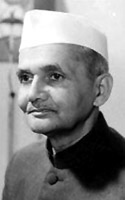 Lal Bahadur Shastri was born on October 2, 1904 and died on January 11, 1966. He was the third Prime Minister of independent India and a significant figure in the Indian independence movement.
Lal Bahadur Shastri was born on October 2, 1904 and died on January 11, 1966. He was the third Prime Minister of independent India and a significant figure in the Indian independence movement.
Early Career of Lal Bahadur Shastri,
Lal Bahadur was born in the year 1904 in Mughalsarai, Uttar Pradesh as Lal Bahadur Srivastava. His father Sharada Prasad was a poor school teacher. When Lal Bahadur was three months old, he slipped out of his mother`s arms into a cowherd`s basket at the ghats of the Ganga. The cowherd, who had no children, took the child as a gift from God. Lal Bahadur`s parents lodged a complaint with the police, who traced the child, and returned him to his parents.
Lal Bahadur`s father died when he was only a year and a half old. His mother Ramdulari Devi took him and his two sisters to her father`s house and settled down there. Since there was no high school in their town, he was sent to Varanasi where he stayed with his maternal uncle and joined the Harischandra High School. While in Varanasi, Shastri once went with his friends to see a fair on the other bank of the Ganges. On his way back he had no money for the boat fare so Instead of borrowing money, he jumped into the river and swam to the other side.
As a boy, Lal Bahadur loved reading books and was devoted to Guru Nanak`s verses. He idolized Bal Gangadhar Tilak, the Indian nationalist, social reformer and freedom fighter. After hearing a speech of Mahatma Gandhi at Varanasi in 1915, he dedicated his life to the service of the country. He also dropped his surname, as it indicated his caste and he was against the caste system. During the non-cooperation movement of Mahatma Gandhi in 1921, he joined processions by taking a bold step against the restrictive order.
Achievements of Lal Bahadur Shastri
Upon completion of his course at Kashi Vidyapeeth in 1926, he was given the title Shastri ("Scholar"). The title was a bachelor`s degree awarded by the Vidya Peeth, but it remained as part of his name. He also enrolled himself as a life member of the Servants of the People Society and began to work for the upliftment of the Harijans at Muzaffarpur. In 1927, Shastri married Lalita Devi of Mirzapur. In spite of the prevailing dowry tradition, Shastri accepted only a charkha and a few yards of khadi as dowry. All his lifetime, Shastri was known for his honesty and humility. He was the first person to be awarded the Bharat Ratna after his death, and a memorial "Vijay Ghat" was built for him in Delhi. Several educational institutes, roads, public squares and monuments in India are named after him. The Lal Bahadur Shastri Stadium in Hyderabad, Andhra Pradesh is an example of this.
In 2005, the Government of India opened the Lal Bahadur Shastri Memorial and set up a library in New Delhi, as part of the Lal Bahadur Shastri Centenary Celebrations. Doordarshan produced a docu-drama on his life, and a national award was instituted in his name. Also, a chair was created in his name in the field of democracy and governance in Delhi University.
Political Achievements of Lal Bahadur Shastri
Following India`s independence, Shastri was appointed as Parliamentary Secretary in his home state, Uttar Pradesh. He became the Minister of Police and Transport under Govind Ballabh Pant`s Chief Ministership. As the Transport Minister, he was the first one to appoint women conductors. As the minister in charge of the Police Department, he ordered that Police use jets of water instead of lathis to drive off unruly crowds. In 1951, he was made the General Secretary of the All-India Congress Committee, with Jawaharlal Nehru as the President.
In 1951, Nehru nominated him to the Rajya Sabha. From 1951 to 1956 Shastri served as the Minister of Railways and Transport in the Central Cabinet. However Shastri resigned accepting moral and constitutional responsibility for a railway accident at Ariyalur that resulted in 144 deaths. Prime Minister, Jawaharlal Nehru, stated that he was accepting the resignation because it would set an example in constitutional decorum and not because Shastri was in any way responsible for the accident. Shastri`s unprecedented gesture was greatly appreciated by the Indian citizens. In 1957, Shastri returned to the Cabinet, first as the Minister for Transport and Communications, and then as the Minister of Commerce and Industry. In 1961, he became Minister for Home. As Union Home Minister he was instrumental in appointing the Committee on Prevention of Corruption under the Chairmanship of K. Santhanam.
After Jawaharlal Nehru died in office on May 27, 1964 Shastri was made the Prime Minister. Shastri worked by his natural characteristics to obtain compromises between opposing viewpoints. However, he commanded a great deal of respect in the Indian citizens, and he used it to advantage in pushing the Green Revolution in India, which directly led to India becoming a food-surplus nation, although he did not live to see it. During the 22 day war with Pakistan, Lal Bahadur Shastri created the slogan of "Jai Jawan, Jai Kisan" ("Hail the solider, Hail the farmer"), emphasising the need to boost India`s food production.
Apart from emphasizing the Green Revolution, he was instrumental in promoting the White Revolution. He is the only Indian Prime Minister, and indeed probably one of the few heads of government, to have died in office outside the country. Some conspiracy theories alleges his death to be of unnatural causes.






